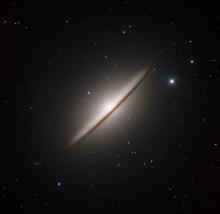Listen to today's episode of StarDate on the web the same day it airs in high-quality streaming audio without any extra ads or announcements. Choose a $8 one-month pass, or listen every day for a year for just $30.
You are here
Black-Hole Middleweight
Fifteen years ago as seen from Earth, a star in a distant galaxy suffered a violent death: It was pulled apart by a black hole. As the star was ripped to shreds, it produced an outburst of X-rays. Over the following decade, it slowly cooled and faded.
Astronomers have seen this scenario play out dozens of times. But this one was special. It may have been created by a middleweight black hole — a type that’s rarely seen.
Earlier events were powered by supermassive black holes. They’re millions or billions of times as heavy as the Sun, and they’re found in the hearts of most galaxies.
In October of 2003, though, X-ray telescopes in space noted a brilliant flare in a remote galaxy. The flare came from the galaxy’s edge, not its center. From its brightness, temperature, and the way it faded, astronomers estimated the heft of the disrupting black hole: about 50,000 times the mass of the Sun.
So far, astronomers have found only a few dozen good candidates for this class of black holes. They’re important, though, because they could be the “seeds” from which bigger black holes grow. To understand that process, astronomers need to see a lot of these middleweights. But they’re tough to find.
This was the first possible detection made through the disruption of a star. But it suggests that many other middleweight black holes could be sitting quietly — waiting for unlucky stars to point them out.
More tomorrow.
Script by Damond Benningfield






